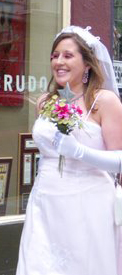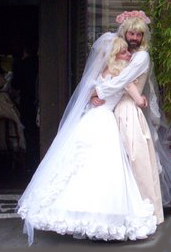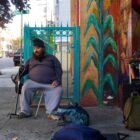 |
| Lissy Jeddeloh, 28, of Davis, strolls on Bush Street Saturday as part of the Brides of March urban prank./Photo by Audrey Wong |
When “Sister Sara Femme” and the other “brides” boarded a tourist bus in Union Square Saturday, the passengers broke out in smiles.
“We’re free entertainment,” Femme said, batting her eyes.
A member of the Sisters of Perpetual Indulgence – a gay activist organization – Femme and her cohorts were a handful of more than 200 people who dressed in wedding gowns, formal attire and more during the 11th annual Brides of March event in downtown San Francisco.
The women – and men – who take part in the festive celebration, don thrift store matrimonial wear and stroll through the city’s tourist areas drawing stares, grins and waves. This year, Femme sashayed in a pink silk gown altered to fit her broad shoulders.
People who practice this type of street theater refer to these events as urban pranks. Other similar yearly gatherings include the hundreds of Santa Clauses, who storm the city during the holiday season, and the zombie trek. However, one recent prank – the annual Valentine’s Day pillow fight – drew the ire of city officials because of the feathery mess left at Justin Herman Plaza.
Officials from the city’s Public Works and Recreation and Parks departments estimated the cleanup cost at thousands of dollars. A Recreation and Parks official said pillow fight organizers should have obtained a permit and paid a fee to use the plaza. The only problem is, applying for a permit goes against the principles of urban pranks, said John Law, a longtime urban prankster whose shenanigans date back to 1977 when he joined the Suicide Club, a group that staged such stunts.
Law said urban pranks allow people to create and socialize.
“People love it because it’s not controlled by corporations,” said Law, 50, who also is a fiction author and special projects coordinator for the local listings Web site Laughing Squid.
Urban prank organizers, who often remain anonymous or use aliases, advertise their events through the Internet or text messages. They don’t know who or how many people will show up.
 |
| Photo by Audrey Wong |
Ethos of harmlessness
An urban prank should never be mean-spirited or target anyone, said a 62-year-old San Francisco man who organized the Brides of March and identifies himself alternately as Michele Michele and Michael Michael. “A good prank challenges the status quo,” he said. “A bad prank is destructive or dangerous. A good prank challenges ways of thinking without being destructive.”
Michele was looking at a rack of wedding dresses in a thrift store in 1999 and pondered how commercialized weddings had become, losing the real meaning of marriage. He decided to take the symbol of the bride’s gown and twist it. Brides of March participants browse through fancy stores and drink at bars while primarily dressed as brides, grooms or priests.
Michele said the brides never caused trouble although storeowners have shooed them out of businesses fearing they would make mischief. San Francisco police Sgt. Wilfred Williams said there is no record of any criminal activity during urban pranks, however, whenever people suddenly gather, police are prepared to provide crowd control.
“This is San Francisco, it happens all the time,” Williams said. “We’ve had plenty of prior practice responding to spontaneous events.”
Williams said police have a protocol for handling unexpected groups, but he would not give details of the plan.
Michele said controversy over this year’s pillow fight was blown out of proportion. Law said the organizers should have planned better ways to have participants help clean up.
Members of the Suicide Club followed the rule to “never leave a trace,” Law said. Whether it was a vampire role-playing game in an abandoned mortuary or scaling the pillars of the Golden Gate Bridge, members always cleaned after themselves and left everything as it was. Burning Man, the annual artistic gathering in the north Nevada desert, also adopted this rule.
Counterculture origins
When Law joined the Suicide Club in the 1970s, members couldn’t rely on the Internet to invite people to their events. People joined through word of mouth and learned of happenings through a newsletter. As a result, groups were much smaller and slower to gather. Anybody could plan a prank, but they couldn’t predict how it would turn out.
Suicide Club members explored abandoned buildings, staged mini-plays in elevators and infiltrated the Moonies and American Nazi Party. They required everyone to be sober for the riskier stunts.
Some members of the Suicide Club helped form the San Francisco Cacophony Society in 1986, of which Michele is a part. Antics of the Suicide Club and Cacophony Society have become mainstream, evolving into such phenomena as Burning Man – which now is a business – and the Chinese New Year’s Treasure Hunt that today, is a fundraiser.
Cacophony members wanted to shake the public’s ideas of Christmas in 1994 by wearing cheap Santa Claus suits and crashing debutante parties and high-end department stores. The sight of 100 Santa Clauses shocked the public, Law said. Law quit “Santarchy,” also called Santacon and Santa Rampage, after about five years because San Franciscans were becoming accustomed to the fuzzy red horde.
Law said the event inspired others to put on costumes and create their own pranks. The Internet helped urban pranksters get their word out faster and invite more people and has propelled Santarchy to spread around the world.
Both Law and Michele said the popularity of urban pranks indicates people want to interact with each other in creative ways.
“We live in very rigid society,” Michele said. “It’s like breaking out of boundaries and coming up with new ideas and looking at things from a new perspective.”










